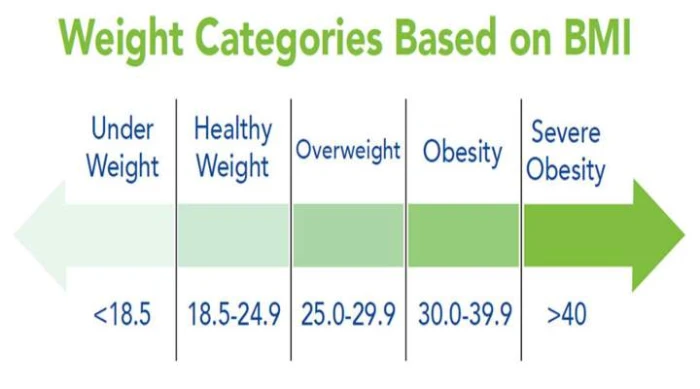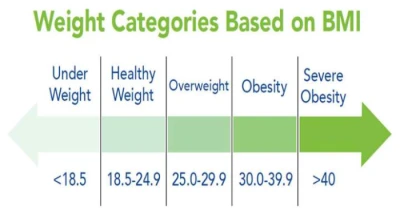BMI Myths and Misconceptions - Ultimate Guide
BMI is a simple way to guess how healthy you are based on your height and weight. It's like a quick measurement.

BMI is a simple way to guess how healthy you are based on your height and weight. It's like a quick measurement. However, many people have wrong ideas about what BMI means. This guide will help you to understand BMI thoroughly and in a better way.
Myths about BMI
We'll clear up the confusion and explain what BMI can tell you about your health and what the limitations of BMI are.
What the Parameter BMI Tells You About Your Health?
BMI is a number that shows how much you weigh compared to how tall you are. It's found by dividing your weight in kilograms by your height in meters multiplied by it. It categorizes individuals into different weight statuses - underweight, average weight, overweight, and obese. Despite its widespread use, BMI has limitations and is often misunderstood.
Myth 1 - BMI Accurately Reflects Body Fat
One of the most prevalent myths is that BMI is a precise indicator of body fat. In reality, BMI doesn't distinguish between muscle and fat. Like athletes, people with lots of muscles can weigh a lot but have little body fat. Conversely, individuals with low muscle mass might have a normal BMI but high body fat.
Myth 2 - BMI is Universally Applicable
BMI was developed based on data from European populations and does not account for ethnic and genetic differences in body composition. For example, Asians tend to have higher body fat percentages at lower BMI levels compared to Caucasians. Therefore, BMI cut-offs might not be universally applicable and could lead to misclassification in specific populations.
Myth 3 - BMI Determines Health
Being overweight can make you more likely to get sick, such as with heart problems, diabetes, or high blood pressure. But just because you're overweight doesn't always mean you're unhealthy. Many other factors, such as diet, physical activity, genetics, and metabolic health, play significant roles in an individual's overall health. People with a normal BMI can still be at risk for health issues if they have poor lifestyle habits.
Myth 4 - BMI is a Diagnostic Tool
BMI is a screening tool, not a diagnostic one. It can indicate whether an individual might be underweight, overweight, or obese, but it does not diagnose specific health conditions. A comprehensive health assessment requires additional tests and evaluations, such as body fat analysis, blood tests, and physical exams.
Myth 5 - All Obese Individuals are Unhealthy
Not all individuals with a high BMI are unhealthy. Some people with obesity may have a healthy metabolic profile, a condition known as metabolically healthy obesity (MHO). These individuals do not exhibit the typical metabolic issues associated with obesity, such as insulin resistance or inflammation. Conversely, some individuals with a normal BMI can have metabolic disorders.
Misconceptions about BMI
Misconception 1 - BMI is the Only Measure of Healthy Weight
BMI is just one of many tools used to assess healthy weight. Other measures, such as waist-to-hip ratio, waist circumference, and body fat percentage, provide additional insights into an individual's health. Combining these measures with BMI offers a more comprehensive understanding of body composition and associated health risks.
Misconception 2 - BMI Remains Constant over Time
BMI can fluctuate throughout a person's life due to various factors, including aging, hormonal changes, and lifestyle modifications. For instance, muscle mass typically decreases with age, which can affect BMI. It's essential to watch your health closely and care for your whole body to stay healthy and feel good overall.
Here are some common questions associated with BMI considerations and calculations.
How is Adult BMI Different from that of Children and Adolescents?
Adult BMI (Body Mass Index) differs from that of children and adolescents primarily in how it is interpreted. The resulting number is then classified as underweight, average weight, overweight, and obesity, based on standard cut-off points. In contrast, for children and adolescents, BMI is age and sex-specific. The BMI for children is plotted on growth charts provided by the CDC or WHO, which account for the differences in body fat percentage, growth rates, and developmental stages between boys and girls as they grow.
This results in a BMI percentile, which indicates how a child's BMI compares to others of the same age and sex. For example, a child in the 85th percentile has a higher BMI than 85% of their peers. This percentile approach helps account for the natural variations in growth and development during childhood and adolescence.
Aside from BMI, What Other Techniques or Metrics Are Used to Evaluate Body Composition and Overall Health?
Besides BMI, several other techniques and metrics are used to evaluate body composition and overall health. These include the following.
- Waist Circumference
It measures belly fat, which can show the risk of heart disease and type 2 diabetes.
- Waist-to-Hip Ratio
It compares the waist size to the size of the hips. If the waist is much larger than the hips, it means there is a higher chance of getting heart disease and type 2 diabetes.
- Body Fat Percentage
Using different methods like bioelectrical impedance analysis, dual-energy X-ray absorptiometry (DEXA), and Skinfold measurement, you can measure this. These methods give a more accurate measure of body fat than BMI.
- Bioelectrical Impedance Analysis (BIA)
It estimates body fat and muscle mass by seeing how well the body's tissues resist electrical currents.
- Hydrostatic Weighing
Measures body density by comparing a person's weight on land to their weight underwater. It is considered one of the most accurate methods for determining body fat percentage.
- Magnetic Scans and CT Scans
These imaging techniques provide detailed images of body tissues, allowing for precise measurement of fat distribution.
Skinfold Measurement
- Involves pinching and measuring the thickness of skin folds at various body sites to estimate body fat percentage.
How Does a Person's BMI Get Determined by Their Genetics?
Research shows that our genes can affect our weight and body shape by controlling how hungry we feel, how fast we burn calories, how our body stores fat, and how much energy we use. Some specific genes, like the FTO gene, are linked to obesity and high BMI because they influence how much we eat and our appetite. However, while genetics can predispose individuals to higher or lower BMI, environmental factors such as diet, physical activity, and lifestyle play crucial roles. The interaction between genetics and environment means that even those with a genetic predisposition to a higher BMI can often manage their weight through healthy lifestyle choices.
What Are Some Techniques People Can Employ to Reach a Healthy BMI?
To reach a healthy BMI, individuals can employ the following several techniques.
- Behavioral Changes
Implementing strategies such as mindful eating, portion control, and keeping a food diary to monitor intake and identify unhealthy eating patterns.
- Consistent Sleep Patterns
Ensuring adequate and consistent sleep, as poor sleep can affect metabolism and appetite regulation.
- Stress Management
Employing meditation, yoga, or other stress-relief practices to prevent stress-induced overeating.
- Professional Guidance
Seeking advice from healthcare providers, nutritionists, or personal trainers for personalized plans and support.
- Hydration
Drinking lots of water daily can help you feel less hungry and keep your body's processes working well.
What is the Relationship between BMI and Other Health Indicators like Blood Pressure, Cholesterol, and the Chance of Developing Chronic Diseases?
BMI is a common way to check body fat and can help show health risks. If you are too heavy or fat, it can be bad for your health. This extra fat can also cause inflammation and make it harder for your body to use insulin correctly, which can result in high blood pressure, high blood sugar, more belly fat, and bad cholesterol.
A high BMI is often related to high blood pressure and cholesterol, which can raise the risk of heart disease and stroke. On the other hand, a low BMI can mean malnutrition, weak bones, and a weakened immune system. Keeping a healthy BMI with a balanced diet and regular exercise can lower these risks and improve overall health. However, BMI doesn't tell the whole story because it doesn't separate muscle from fat, so it should be used with other health checks for a complete picture.
BMI is a valuable screening tool with significant limitations and should not solely measure an individual's health. Understanding its myths and misconceptions helps use BMI more effectively and with other health assessments. Considering multiple factors and individual differences, a comprehensive approach is crucial for accurate health evaluation and management.
You can have more grip on monitoring your health if you use a BMI Calculator. You can easily access our BMI Calculator by clicking here.

BMI is a simple way to guess how healthy you are based on your height and weight. It's like a quick measurement. However, many people have wrong ideas about what BMI means. This guide will help you to understand BMI thoroughly and in a better way.
Myths about BMI
We'll clear up the confusion and explain what BMI can tell you about your health and what the limitations of BMI are.
What the Parameter BMI Tells You About Your Health?
BMI is a number that shows how much you weigh compared to how tall you are. It's found by dividing your weight in kilograms by your height in meters multiplied by it. It categorizes individuals into different weight statuses - underweight, average weight, overweight, and obese. Despite its widespread use, BMI has limitations and is often misunderstood.
Myth 1 - BMI Accurately Reflects Body Fat
One of the most prevalent myths is that BMI is a precise indicator of body fat. In reality, BMI doesn't distinguish between muscle and fat. Like athletes, people with lots of muscles can weigh a lot but have little body fat. Conversely, individuals with low muscle mass might have a normal BMI but high body fat.
Myth 2 - BMI is Universally Applicable
BMI was developed based on data from European populations and does not account for ethnic and genetic differences in body composition. For example, Asians tend to have higher body fat percentages at lower BMI levels compared to Caucasians. Therefore, BMI cut-offs might not be universally applicable and could lead to misclassification in specific populations.
Myth 3 - BMI Determines Health
Being overweight can make you more likely to get sick, such as with heart problems, diabetes, or high blood pressure. But just because you're overweight doesn't always mean you're unhealthy. Many other factors, such as diet, physical activity, genetics, and metabolic health, play significant roles in an individual's overall health. People with a normal BMI can still be at risk for health issues if they have poor lifestyle habits.
Myth 4 - BMI is a Diagnostic Tool
BMI is a screening tool, not a diagnostic one. It can indicate whether an individual might be underweight, overweight, or obese, but it does not diagnose specific health conditions. A comprehensive health assessment requires additional tests and evaluations, such as body fat analysis, blood tests, and physical exams.
Myth 5 - All Obese Individuals are Unhealthy
Not all individuals with a high BMI are unhealthy. Some people with obesity may have a healthy metabolic profile, a condition known as metabolically healthy obesity (MHO). These individuals do not exhibit the typical metabolic issues associated with obesity, such as insulin resistance or inflammation. Conversely, some individuals with a normal BMI can have metabolic disorders.
Misconceptions about BMI
Misconception 1 - BMI is the Only Measure of Healthy Weight
BMI is just one of many tools used to assess healthy weight. Other measures, such as waist-to-hip ratio, waist circumference, and body fat percentage, provide additional insights into an individual's health. Combining these measures with BMI offers a more comprehensive understanding of body composition and associated health risks.
Misconception 2 - BMI Remains Constant over Time
BMI can fluctuate throughout a person's life due to various factors, including aging, hormonal changes, and lifestyle modifications. For instance, muscle mass typically decreases with age, which can affect BMI. It's essential to watch your health closely and care for your whole body to stay healthy and feel good overall.
Here are some common questions associated with BMI considerations and calculations.
How is Adult BMI Different from that of Children and Adolescents?
Adult BMI (Body Mass Index) differs from that of children and adolescents primarily in how it is interpreted. The resulting number is then classified as underweight, average weight, overweight, and obesity, based on standard cut-off points. In contrast, for children and adolescents, BMI is age and sex-specific. The BMI for children is plotted on growth charts provided by the CDC or WHO, which account for the differences in body fat percentage, growth rates, and developmental stages between boys and girls as they grow.
This results in a BMI percentile, which indicates how a child's BMI compares to others of the same age and sex. For example, a child in the 85th percentile has a higher BMI than 85% of their peers. This percentile approach helps account for the natural variations in growth and development during childhood and adolescence.
Aside from BMI, What Other Techniques or Metrics Are Used to Evaluate Body Composition and Overall Health?
Besides BMI, several other techniques and metrics are used to evaluate body composition and overall health. These include the following.
- Waist Circumference
It measures belly fat, which can show the risk of heart disease and type 2 diabetes.
- Waist-to-Hip Ratio
It compares the waist size to the size of the hips. If the waist is much larger than the hips, it means there is a higher chance of getting heart disease and type 2 diabetes.
- Body Fat Percentage
Using different methods like bioelectrical impedance analysis, dual-energy X-ray absorptiometry (DEXA), and Skinfold measurement, you can measure this. These methods give a more accurate measure of body fat than BMI.
- Bioelectrical Impedance Analysis (BIA)
It estimates body fat and muscle mass by seeing how well the body's tissues resist electrical currents.
- Hydrostatic Weighing
Measures body density by comparing a person's weight on land to their weight underwater. It is considered one of the most accurate methods for determining body fat percentage.
- Magnetic Scans and CT Scans
These imaging techniques provide detailed images of body tissues, allowing for precise measurement of fat distribution.
Skinfold Measurement
- Involves pinching and measuring the thickness of skin folds at various body sites to estimate body fat percentage.
How Does a Person's BMI Get Determined by Their Genetics?
Research shows that our genes can affect our weight and body shape by controlling how hungry we feel, how fast we burn calories, how our body stores fat, and how much energy we use. Some specific genes, like the FTO gene, are linked to obesity and high BMI because they influence how much we eat and our appetite. However, while genetics can predispose individuals to higher or lower BMI, environmental factors such as diet, physical activity, and lifestyle play crucial roles. The interaction between genetics and environment means that even those with a genetic predisposition to a higher BMI can often manage their weight through healthy lifestyle choices.
What Are Some Techniques People Can Employ to Reach a Healthy BMI?
To reach a healthy BMI, individuals can employ the following several techniques.
- Behavioral Changes
Implementing strategies such as mindful eating, portion control, and keeping a food diary to monitor intake and identify unhealthy eating patterns.
- Consistent Sleep Patterns
Ensuring adequate and consistent sleep, as poor sleep can affect metabolism and appetite regulation.
- Stress Management
Employing meditation, yoga, or other stress-relief practices to prevent stress-induced overeating.
- Professional Guidance
Seeking advice from healthcare providers, nutritionists, or personal trainers for personalized plans and support.
- Hydration
Drinking lots of water daily can help you feel less hungry and keep your body's processes working well.
What is the Relationship between BMI and Other Health Indicators like Blood Pressure, Cholesterol, and the Chance of Developing Chronic Diseases?
BMI is a common way to check body fat and can help show health risks. If you are too heavy or fat, it can be bad for your health. This extra fat can also cause inflammation and make it harder for your body to use insulin correctly, which can result in high blood pressure, high blood sugar, more belly fat, and bad cholesterol.
A high BMI is often related to high blood pressure and cholesterol, which can raise the risk of heart disease and stroke. On the other hand, a low BMI can mean malnutrition, weak bones, and a weakened immune system. Keeping a healthy BMI with a balanced diet and regular exercise can lower these risks and improve overall health. However, BMI doesn't tell the whole story because it doesn't separate muscle from fat, so it should be used with other health checks for a complete picture.
BMI is a valuable screening tool with significant limitations and should not solely measure an individual's health. Understanding its myths and misconceptions helps use BMI more effectively and with other health assessments. Considering multiple factors and individual differences, a comprehensive approach is crucial for accurate health evaluation and management.
You can have more grip on monitoring your health if you use a BMI Calculator. You can easily access our BMI Calculator by clicking here.
Conversation
Latest Blogs
© Blog CoolCalculator, Explore CoolCalculator, your destination for the latest insights, tips, and updates on the world of online calculators. Stay informed and make your calculations smarter with our blog. ,
Designed
by Saad Media Team , Team Lead M.Rizwan Akhtar












